Wi-Fi Site Surveys, Analysis, Troubleshooting runs on a MacBook (macOS 11+) or any laptop (Windows 7/8/10/11) with a standard 802.11be/ax/ac/n/g/a/b wireless network adapter. Read more about the 802.11be support here.
How to troubleshoot Wi-Fi Interference with NetSpot
WiFi problems? It might not be your ISP. More often than not, it’s interference — and unless you’ve got a reliable WiFi interference scanner, you're just guessing.
Wireless interference is simply anything that corrupts the radio your WiFi uses. Modern WiFi networks face new types of interference daily: crowded 2.4 GHz bands, overlapping channels in apartment buildings, emerging 6 GHz devices, and even smart home gadgets competing for signal. That’s where a WiFi interference scanner becomes essential.
Instead of guessing, you need real data. A good scanner shows exactly where the interference happens, what causes it (neighboring networks, microwaves, smart TVs, etc.), and how to fix it — whether it’s switching channels, changing frequency bands, or upgrading hardware.
Modern networks face new challenges: the shift to WiFi 6E/7 introduces 6 GHz bands for less congestion, but issues like adjacent-channel interference (ACI) and co-channel interference (CCI) still don’t go away. ACI appears when nearby channels spill into each other, CCI happens when several networks sit on the same channel.
Even though modern routers try to fight this with dynamic channel selection and next-gen anti-interference features, including AI-driven automation, they can’t always guess the real RF situation around you.
Users often search for “WiFi interference fix” or “reduce WiFi interference”, and this question can actually be answered if you first look at your wireless environment with a WiFi interference scanner. You can reveal the true picture: overlapping channels, congestion, or signal leakage from nearby networks. Once detected, you can take practical steps to fix it. Let’s walk through this process in more detail.
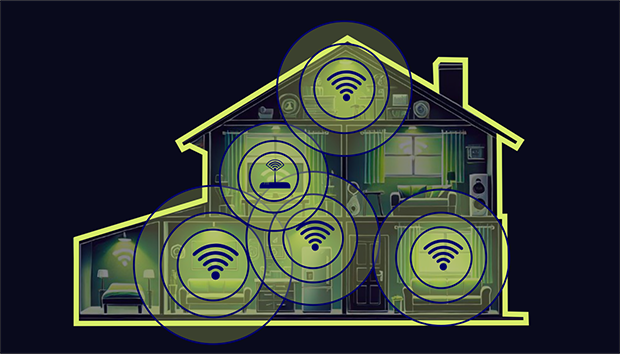
How to Fix WiFi Interference: Step-by-Step
Most users aren’t looking for theory — they just want a clear solution. Here’s how to get started:
Step 1: Scan the Environment with a WiFi Interference Scanner
The first step to solving any WiFi issue is to detect it properly. You can’t fix what you can’t see. That’s where a WiFi interference scanner comes in. Use a dedicated app to scan your wireless environment and see exactly what’s going on with both your network and surrounding ones.
Tools like NetSpot let you visualize:
- Signal-to-noise ratio (SNR)
- Overlapping channels
- Channel utilization
- PHY mode and band usage
NetSpot displays this information in real time using clear signal graphs, channel overlap charts and build WiFi heatmaps. It supports 6 GHz scanning and detects hidden networks, making it ideal for troubleshooting interference in modern networks. Once you see the full picture, it becomes much easier to decide which interference-mitigation steps to take next.
Step 2: Identify the Cause of WiFi Interference
Scanning is just the beginning — now it's time to interpret the results. The key is to match what you’re seeing with how your WiFi is behaving. Here are the most common scenarios:
- Strong signal near router, but major drops through walls (especially on 5 GHz)?
You're dealing with physical barriers like brick or reinforced concrete. WiFi at 5 GHz doesn’t penetrate well.
- Signal strength is good (around –50 to –60 dBm), but speed is unstable and video calls freeze?
This is likely WiFi‑to‑WiFi interference — multiple networks using the same or overlapping channels (CCI or ACI). The fastest way to confirm that the problem is interference, not just weak signal, is to run a WiFi interference scanner. This is exactly what you need to see whether the problem is classic 2.4 GHz congestion or a newer WiFi 6E/7 scenario.
- Problem only happens when a microwave, baby monitor, or Bluetooth speaker is in use?
That’s non-WiFi interference — these devices emit signals in the 2.4 GHz range.
- WiFi only fails in a specific room or corner, but works fine elsewhere?
That’s a placement issue or a local dead zone.
- Everything slows down in the evening but works fine in the morning?
Classic case of network congestion from neighbors — their routers are waking up too.
- Slow speeds even right next to the router?
The problem likely isn’t interference at all — it's your ISP or a misbehaving router.
Step 3: Take Action Based on the Cause
Now that you’ve identified what’s interfering with your WiFi, here’s how to respond:
Positioning of a Wireless Router
If the problem is weak Wi-Fi in certain rooms, start with the router’s location. Obviously the way you position your wireless router will have effect on your coverage area and WiFi signal strength. Incorrect placement can lead to weak signals, dead zones, and slow network speeds.
How to troubleshoot :
- Position your wireless router in the middle of the space where the network is needed. If the router is placed off-center, the signal won't be even, leaving some areas with poor coverage.
- Ensure the router antenna is vertical. While many antennas can be adjusted, a straight-up position typically provides the best performance. For routers with multiple antennas, angling them differently, such as one vertical and one diagonal, can enhance signal coverage.
- Place your router on an elevated surface. A desk or shelf will provide better reception compared to placing it on the floor. Avoid positioning it near electronic devices like microwaves or cordless phones, as well as metal objects or mirrors, which can cause radio frequency interference.
- If you have multiple floors, position your wireless router on a higher floor. This helps the signal radiate downward more effectively, improving coverage across all levels.
Real-world example: Wi-Fi heatmap after relocating the router — areas with poor signal (green/blue) became much stronger (red), just by moving the router to a better spot.
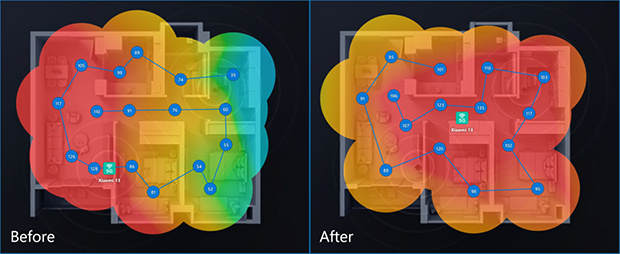
To get the most out of your Wi-Fi setup, use tools like NetSpot to analyze your network and create a heatmap. This allows you to visualize signal strength and make data-driven adjustments to position your wireless router optimally.
Physical obstacles
The construction of a building, whether it’s a home or office, significantly affects the range and speed of wireless communication. One of the main WiFi interference causes is the presence of physical obstacles that weaken or block the radio waves used by Wi-Fi. Understanding what interferes with WiFi is critical for optimizing your network’s performance.
Different materials have varying levels of impact on Wi-Fi signals. While wood and glass cause minimal disruption, materials like concrete, brick, and metal can drastically degrade signal quality and lead to slow network speeds.
How to troubleshoot :
If you suspect physical obstacles are causing wireless interference, there are a few simple steps you can take to improve signal strength:
- Relocate the Wireless Device: Even moving a Wi-Fi routers or device a few feet can have a noticeable impact on signal quality. Adjusting the antenna direction can also help reduce WiFi interference.
- Add a Wi-Fi extender : For spaces where physical obstacles cannot be avoided, a Wi-Fi extender can re-transmit the signal, ensuring better coverage even in remote areas. This is particularly useful for overcoming WiFi signal interference caused by thick walls or multiple floors.
- Consider Powerline Adapters: In larger spaces with challenging layouts, Powerline adapters use your existing electrical wiring to extend the network. Pairing them with a Wi-Fi extender provides a reliable solution for areas with high wireless interference.
Overlapping channels
Many devices, even those not directly connected to your WiFi network, can cause frequency interference by operating on the same 2.4 GHz, 5 GHz оr even 6 GHz spectrum. This interference disrupts the radio waves your WiFi depends on, meaning the network may be slower or disconnect, resulting in frustratingly poor performance. Recognizing what causes WiFi interference and addressing it is key to maintaining a reliable connection.
To help you identify and address what interferes with WiFi, here’s a detailed table showing the most common interference sources, their impact on your network, and practical solutions:
| Interference Source | Impact on Wi-Fi | Solution |
| Microwave | Causes interference, especially in the 2.4 GHz spectrum, slowing the network or causing disconnects when in use. | Place the router away from the microwave, especially for older routers operating on 2.4 GHz. |
| Cordless Phonee | Interferes with 2.4 GHz spectrum during active calls, leading to large signal disruptions. | Use DECT phones or move the router away from cordless phones. |
| Poorly Wired Satellite Dish | Can cause significant signal interference if improperly wired or with deteriorating cables. | Ensure proper wiring and replace deteriorating cables for satellite dishes. |
| Other Wireless Devices | Generates interference from wireless speakers, baby monitors, and devices on 2.4 GHz or 5 GHz. | Keep devices like wireless cameras and speakers away from the router; switch to 5 GHz if possible. |
| Power Sources | Creates interference from nearby power lines, electrical tracks, or breaker boxes. | Avoid placing the router near power lines or electrical equipment. |
| Poorly Shielded Cables | Introduces interference if cables are poorly shielded; can be resolved by replacing cables. | Replace poorly shielded cables and avoid running cables parallel to power lines. |
| External Monitors and LCD Displayss | Causes interference in the 2.4 GHz band (channels 11-14), worsened with connected external monitors. | Move the router to a different location or switch to 5 GHz or lower 2.4 GHz channels. |
| Neighbors' WiFi | Strong overlapping networks can create signal congestion and reduce network performance. | Change your Wi-Fi channel or use 5 GHz to avoid overlapping interference. |
Use your WiFi interference scanner to see which of these is the least crowded in your area right now.
How to troubleshoot :
- If the problem is overlapping channels, pick another channel.
- If the problem is non-WiFi interference from household devices, switch to 5 GHz or 6 GHz, where those devices don’t operate.
- If the problem is signal loss after walls, switch the client in that room to 2.4 GHz (better penetration) or extend the network with a mesh/AP.
- If the problem is evening congestion, open the scanner again and move to a channel that is currently cleaner. Some routers can do this automatically.
- If your router supports it, enable smart/dynamic channel selection so it can react to changing interference levels without you.
- If you’re in a crowded apartment building and use wide channels, try narrowing the channel width from 40 MHz down to 20 MHz to reduce adjacent-channel interference.
- If it stays slow right next to the router, run an ISP speed test (wired if possible), reboot the router, and check for firmware updates.
Real-world example: many users never check what channel their access point is using and just leave the factory settings. In the “before” situation you can see almost all networks sitting in the same part of the 2.4 GHz band and overlapping each other, while a couple of channels on the right stay free. After switching the AP to one of these unused channels, the network moves out of the crowded area and the interference drops. In simple cases, changing the channel to a free one is enough to fix unstable WiFi.

How to Pick the Right WiFi Channel (Even If You’re Not Sure):
If you're not sure which WiFi channel to pick, here's a simple way to figure it out. There are three types of channel overlap, and each affects your network differently:
- No Overlap (best case): Networks use completely separate channels, resulting in no interference and optimal performance.

- Full Overlap (not ideal, but manageable): Networks use the same channel but can negotiate access due to Wi-Fi's collision avoidance protocols, minimizing interference compared to partial overlap.
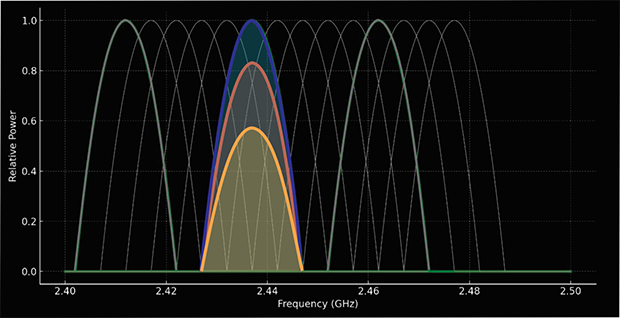
- Partial Overlap (worst case): Networks use adjacent channels, which creates significant interference as signals are seen as noise by each other.
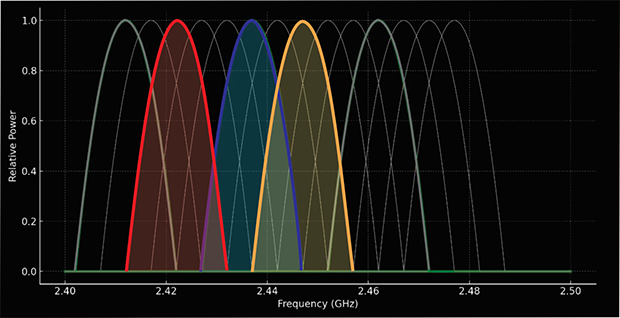
The NetSpot Android app includes a built-in Best Channel Recommendation feature. It automatically analyzes nearby networks and tells you which channel is optimal — perfect if you're not sure how to read channel graphs.

Analyze WiFi networks around you, perform wireless surveys, and test Internet speed — all with just a phone or tablet in your hands.


Why NetSpot Is the Best WiFi Interference Scanner for Your Network
NetSpot isn’t just a scanner — it’s a full suite for interference detection, channel optimization, and predictive planning. Its features include:
Inspector Mode: shows a clear, structured table with the most important data about nearby networks (SSID, BSSID, channel, band, security, signal level), plus a real-time Signal Strength graph and Channel graphs, including 6 GHz.
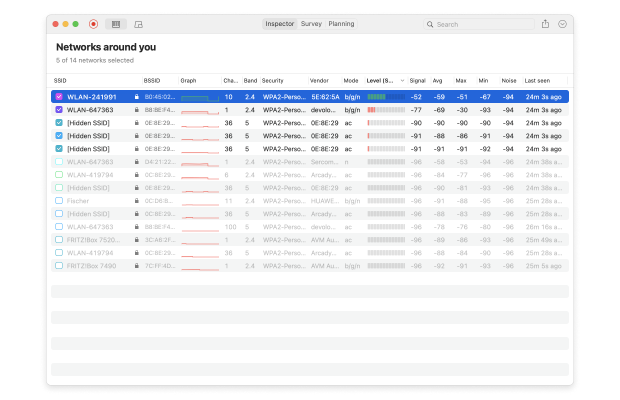
Everything is visual, easy to read, and can be filtered by band, channel, signal strength, security, or vendor — perfect when you need to see which networks create interference right now.
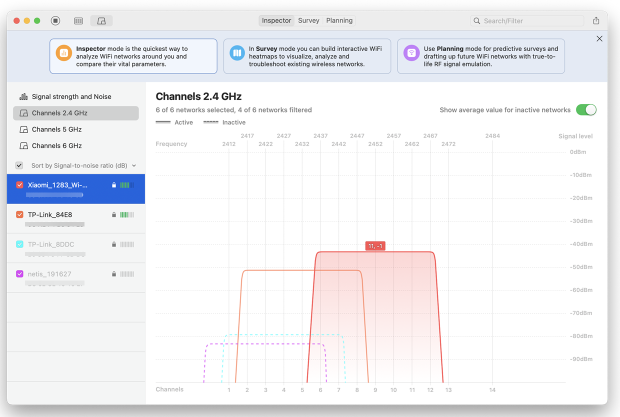
Survey Mode: lets you build multiple Wi-Fi heatmaps (signal, noise, interference, SNR, download/upload speed, AP quantity, overlapping channels, and more), so you can analyze the environment from every angle. Supports both passive and active scanning, which helps you see not only coverage, but also real performance in problem areas. Very visual and convenient for explaining issues to clients or teammates.
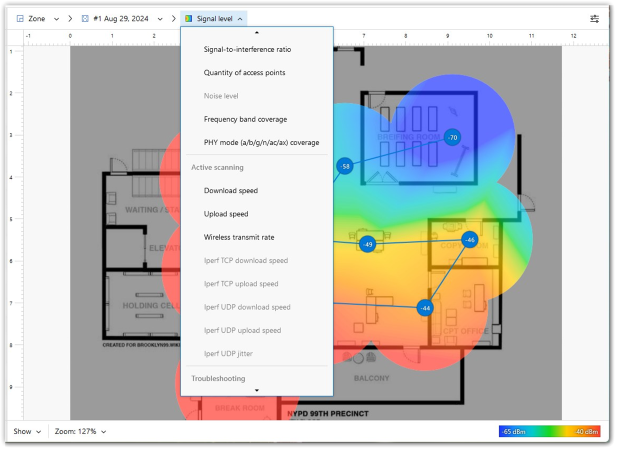
Planning Mode: lets you place virtual access points on the map, pick equipment from a list or enter AP parameters manually, adjust antenna type and direction, and simulate interference-free layouts before you buy hardware. This makes it easy to choose the right AP model, the right number of APs, and their optimal placement.
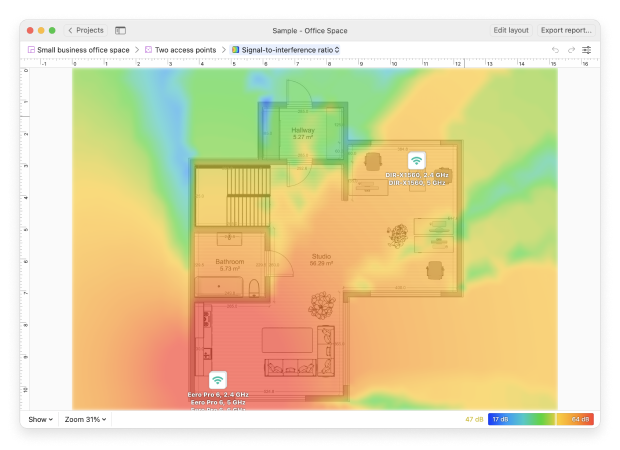
Available for Windows, macOS, and Android, NetSpot helps you detect Wi-Fi interference fast, switch to the best channel, and design a stable network that won’t collapse when neighbors change their settings.
Conclusion
Whether you’re in a crowded city apartment or a multi-level house, WiFi interference can ruin your experience. A WiFi interference scanner like NetSpot gives you the power to not just detect problems, but fix them. As WiFi 6E and 7 become standard, now’s the time to take control of your network’s environment and build a future-proof wireless setup.
WiFi Interference — FAQs
Use a WiFi interference scanner like NetSpot to visualize networks, channels, and interference patterns.
To stop WiFi interference, start by repositioning your wireless router to a central, elevated location, away from walls, mirrors, and metal objects. Use a WiFi interference scanner like NetSpot to identify overlapping networks and choose the least crowded channel. If physical barriers are a problem, consider using Wi-Fi extenders or Powerline adapters to improve coverage in weak areas.
If there is physical interference with your WiFi signal, you can troubleshoot it by performing the following:
- Estimate the very middle of your wirelessly covered area and put your router in it. See how that affects the signal.
- Try setting up the router antenna vertically.
- Put the router on an elevated surface, e.g. a desk.
Wireless interference occurs when external factors disrupt the radio waves used by WiFi to communicate. This can result in slow speeds, dropped connections, and weak signals. Common sources include physical barriers, overlapping networks, and devices operating on similar frequencies.
Start with enabling channel auto-switching on your WiFi router. Look into its user manual if you are not sure how to do it. If the speed is still slow, try setting up a channel manually and perform a speed test. Try NetSpot — it is a great WiFi Channel Scanner.
With the help of NetSpot you can see which wireless channels other networks are using, and what channel might be a better solution for your WiFi network.
